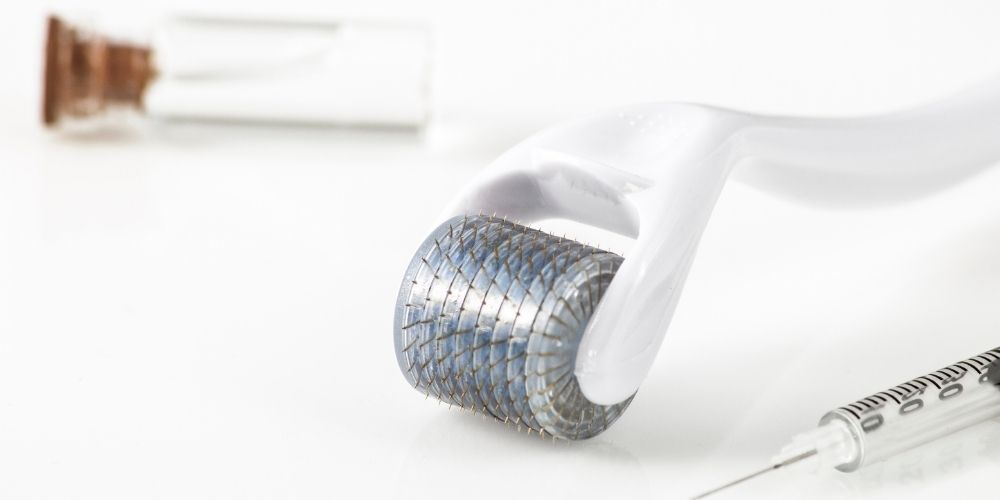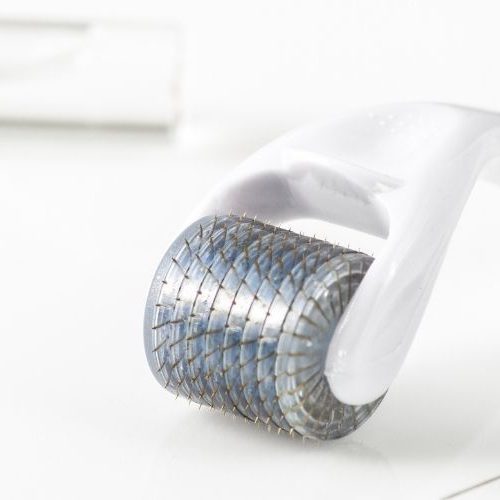Maison » Micro Needling for Hair Loss: What does Dermaroller do?


Hair restoration procedures have been resorted to for many decades. However, the tendency to lose hair seems commonplace now. Hair loss can be genetic or due to some illness or stressors. Some systemically ill individuals or those with few hairs, whether male or female, can cause the early termination of hair follicles. The quest for replacing those lost tresses or reviving the ones on the verge of dropping, with a non-invasive technique, has made the growing population visit clinics for hair transplants with options like mesotherapy, PRP, dermarollers, and finally hair transplants. Concentrating on the newest emerging treatment options with better efficacy and safety also becomes a need of the hour. This text sums up the basics of micro-aiguilletage that would help us shed light on the field of medicine that each future doctor shall come across. Microneedling, also known as percutaneous collagen induction therapy or skin needling, is an acceleration of the wound healing cascade. Microneedling with a dermaroller has had an edge over the rest because of the customized depth, angle, and density of the needle. The increasing demand for a minimally invasive, easy, and less painful technique that can provide a cost-effective treatment for hair loss conditions has made lesser-known technology a popular choice of treatment. Although the studies supporting the use of microneedling for hair are limited, there are proposed mechanisms that could form the basis for its clinical application in hair loss. Microneedling functions by enhancing the dermal papillae, which are responsible for scalp nourishment, oxygenation, and hair growth. Additionally, microneedling can have the beneficial role of promoting vascularization around the hair bulge, which can enhance blood supply and directly promote hair regrowth. It can also target the final effectors for triggering hair growth, which are dermal and epidermal stem cells, and can transform hair in the resting phase to the growth phase. Certain growth factors can also promote and maintain hair growth. When topically applied to the scalp, they directly enhance hair follicle development through mitogenic and anti-apoptotic effects, ultimately helping to increase the diameter and thickness of each hair, resulting in a fuller-looking head of hair. There are proposed mechanisms that can make microneedling a very effective treatment compared to any other. It can address the causes of hair loss at various levels, such as scalp and hair shaft aging, environmental insults, and hormonal causes. Additionally, a genetically rough scalp or a scalp that is in a chronic inflammatory state can be treated with topically applied growth factors, thereby addressing the patient’s condition at another level.
It is likely that after microneedling with a dermaroller, the body’s wound-healing process responds by releasing numerous growth factors active in hair regeneration. Therefore, microneedling with a dermaroller of the scalp creates micro-injuries or stretches in the papillary dermis, thereby triggering an accelerated dismantling process. This process of destructive inflammation in the papillary dermis releases intense pro-inflammatory signals that initiate the healing cascade and lead to the activation of the hair follicles. The activation process generates an intense release of growth factors, of which KGF will be directly linked to the stimulation of the multiplication of hair follicle stem cells in the passive phase of hair growth.
Microneedling also leads to increased blood flow to the scalp, which can support hair growth. It is known that balding skin also shows reduced oxygenation, which indirectly suggests a reduction in blood circulation. The elevation of an important growth factor, the use of growth factor concentrates, and an improvement in scalp blood circulation may contribute to increased hair regrowth. Finally, when microneedling creates micro-injuries in the dermis, it leads to a proliferation of fibroblasts and the intensification of collagen production. Because the unique properties of the matrix also increase the regeneration of the skin, we have every scientific right to discuss this aspect of skin regeneration when we discuss the effect of microneedling.
The efficacy of commercially available cordless dermarollers as a therapeutic modality for hair loss treatment has been encroaching on dermatology in recent years. However, formal reports on their clinical use are scarce in the literature. In this article, we give a brief overview of the evidence-based use of micro-aiguilletage in dermatology. Clinical studies on the efficacy of microneedling for hair loss have shown highly favorable results when microneedling is performed as a sole therapy or as an adjunct to minoxidil. These studies have also shown statistically higher improvement compared to minoxidil, and in some studies, superior improvement to the other prospective or published data of minoxidil, laser, or PRP. Various studies have shown that microneedling can be effective, resulting in hair regrowth, an increase in hair follicle count, an increase in hair follicle width, a reduction in eosinophilic folliculitis, a decrease in sebum levels, a reduction in the telogen rate, and an increase in the anagen rate. Additionally, there are comparative studies showing that microneedling can be as effective as a 5% topical minoxidil solution. The frequency, duration between each session, and treatment duration were not consistent among the different papers. Many patient factors—such as pain, resistance, fear of needles, patient compliance, and treatment expectations regarding the efficacy of microneedling—differ. Most of the papers relied only on the absence of side effects, despite micro-aiguilletage having the potential to cause significant side effects. Patient satisfaction is a crucial issue when assessing the efficacy of any treatment modality. Referring to the discussion, cutaneous microtargets were reported with minimal side effects and thus could be used in patients. Considering the above, there are still many issues requiring clarification and more data in our discussion compared with PRP and fractional laser data. With the development of our experience regarding the use of this methodology for hair loss, results from further consultations will be forthcoming. Given the paucity of data, this work’s aim is not to investigate issues concerning the treatment of alopecia with microneedling but to focus on evidence for the use of microneedling in hair loss.
Microneedling will have greater therapeutic effects if used in combination with other treatment methods. Treatment with 5% minoxidil concurrent with microneedling for 12 weeks was associated with significant improvement in hair regrowth compared with 5% minoxidil alone after 12 weeks by dermoscopy. In a clinical trial with microneedling in isolation, a significant number of patients achieved good results and some degree of hair regrowth. It has been suggested that the combination of micro-aiguilletage and 5% minoxidil has synergistic effects, as microneedling results in an improved delivery of medications across the stratum corneum. Some investigators also assessed microneedling’s potential to increase topical medication delivery or increase the duration of action; one examined the ability of microneedling to improve the efficacy of therapy. Platelet-rich plasma (PRP), suggested to carry growth factors and stem cells, has also been incorporated into microneedling with controversial results. A combined approach of intradermal botulinum toxin and microneedling was also significant to treat androgenetic scarring alopecia.
In the future, scientific advances have to address new technologies and clinical applications, not only for scalp disorders treated with microneedling but also for further improvements offering personalized approaches for combating hair loss and beauty enhancement. These should be the subjects of future research. Personalized combinatorial therapies would require collaborative efforts among dermatologists and trichologists specializing in epidermal growth. Various ethical and personal rights aspects should also be considered with patient consent after explaining the risks and benefits of the new personalized combination therapies. Ethical demand is to explain the importance and the possibility of the synergistic effects of combination therapies in works that have been reported until now.
This systematic review demonstrates that microneedling using a dermaroller yields efficacy in the treatment of various hair loss disorders when used alongside traditional treatments. Several reports are in agreement regarding the mechanism by which microneedling may exert its effects in both AGA and alopecia areata. While overall patient satisfaction is high among these studies, more research needs to be conducted to solidify the efficacious effects of microneedling to confirm its short-term and long-term efficacy and safety as a hair loss treatment.
The review of the evidence found that microneedling for hair loss treatment using a dermaroller may yield positive effects when used in conjunction with traditional hair loss treatments. It was discovered that clinical trials either show significant hair regrowth, an increase in hair growth, or an increase in hair density and/or thickness in the scalp when patients were using traditional treatments in addition to microneedling with needle lengths ranging from 1.5 mm to 3 mm. Proposed mechanisms on how microneedling is effective include growth factor induction leading to hair growth, improved drug absorption and skin penetration, and wounding the skin to kickstart new hair growth. Studies did report some side effects such as temporary localized erythema and pain, with minimal downtime. However, there were no serious adverse outcomes. This review suggests that, with proper patient education, microneedling using a dermaroller can be considered a safe and effective treatment in the armamentarium of hair loss treatments. As such, dermatologists could consider offering micro-aiguilletage treatment in their practice for patients experiencing hair loss, given proper patient education, consent, and realistic expectations. In addition, practitioners should ensure they have adequate knowledge and understanding of the treatment to be able to make a qualified decision on who would be an optimal candidate for hair loss treatment using microneedling.